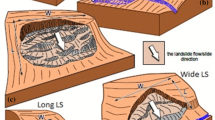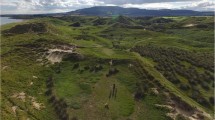Abstract
The dynamicity of the coastal landforms necessitates monitoring from space-borne or aerial remote sensing platforms. Precise elevation information is an important requirement to delineate the subtle topographic variations along and across the coastal axes, indicative of coastal geomorphology at large scale. The study was carried out for a coastal stretch of 25 km, located between Visakhapatnam and Kakinada districts of Andhra Pradesh state, where the depositional activity is dominated. In the present study, we aim to demonstrate the utility of high resolution digital terrain model derived from the advanced Light Detection and Ranging (LiDAR) technology, in identification and delineation of the micro-geomorphic units along this coastline. The four level classifications of the landforms were also proposed based on genesis of landforms, geological sub-provinces, landform shape and morphological attributes as level 1, 2, 3 and 4, respectively. The higher-order landforms of level 4, such as beach berms, beach ridge crest, dune crest and toe, interdunal depression, etc. are delineated using the cross-shore elevation profile, slope and signed curvature information derived from LiDAR DTM with the subtle contrasts of elevation (1–2 m). The beach ridge–swale complex, dune and beach berms were chosen as the key depositional elements to define the morphological attributes in terms of shape and curvature values. This has enabled creation of micro-geomorphology map at 1:5000 scales over the study area as well as classification of the landforms into 4 levels, thus providing significant input for coastal resource mapping and management.









Similar content being viewed by others
References
Cheung, S., Kenneth, C. S., & Cho, H.-C. (2012). Fusing landscape accuracy-dependent SRTM elevation data with NGDC and LiDAR data for the Florida coastline. Remote Sensing Letters,3(8), 687–696.
Choung, Y. J. (2015). Mapping 3D shorelines using KOMPSAT-2 imagery and airborne LiDAR data. Journal of the Korean Society of Surveying, Geodesy, Photogrammetry and Cartography,33(1), 23–30.
Choung, Y.-J., & Jo, M.-H. (2016). Shoreline change assessment for various types of coasts using multi-temporal Landsat imagery of the east coast of SouthKorea. Remote Sensing Letters,7(1), 91–100.
Dhiman, R., Tirodkar, J., & Inamdar, A. B. (2016). Integrating sustainable coastal development initiatives along Maharashtra coast, using ICM guidelines.
Dubayah, O. R., & Drake, J. B. (2000). Lidar remote sensing for forestry. Journal of Forestry, 98(6), 44–46. https://doi.org/10.1093/jof/98.6.44.
Dwarakish, G. S., Vinay, S. A., Natesan, U., Asano, T., Kakinuma, T., Katta Venkataramana, B., et al. (2009). Coastal vulnerability assessment of the future sea level rise in Udupi coastal zone of Karnataka state, west coast of India. Ocean and Coastal Management,52(9), 467–478.
Feagin, R. A., Sherman, D. J., & Grant, W. E. (2005). Coastal erosion, global sea level rise, and the loss of sand dune plant habitats. Frontiers in Ecology and the Environment,3(7), 359–364.
Guha, A., Roy, P., Singh, W., & Vinod Kumar, K. (2018). Integrated use of LANDSAT 8, ALOS-PALSAR, SRTM DEM and ground GPR data in delineating different segments of alluvial fan system in Mahananda and Tista rivers, West Bengal, India. Journal of the Indian Society of Remote Sensing,46(4), 501–514.
Houser, C., Hapke, C., & Hamilton, S. (2008). Controls on coastal dune morphology, shoreline erosion and barrier island response to extreme storms. Geomorphology,100(3–4), 223–240.
Hvidegaard, S. M., Sørensen, L. S., & Forsberg, R. (2012). ASTER GDEM validation using LiDAR data over coastal regions of Greenland. Remote sensing letters,3(1), 85–91.
Jagannadha Rao, M., Greeshma Gireesh, A. G., Avatharam, P., Anil, N. C., & Karuna Karudu, T. (2012). Studies on coastal geomorphology along Visakhapatnam to Bhimunipatnam, east coast of India. Journal of Indian Geophysical Union,16, 179–187.
Kankaraa, R. S., Chenthamil Selvana, S., Markosea, V. J., Rajana, B., & Arockiaraja, S. (2015). Estimation of long and short term shoreline changes along Andhra Pradesh coast using Remote Sensing and GIS techniques. Procedia Engineering,116, 855–886.
Kannan, R., Kanungo, A., & Murthy, M. V. R. (2016). Detection of shoreline changes Visakhapatnam coast, Andhra Pradesh from multi-temporal satellite images. Journal of Remote Sensing & GIS,5(157), 2.
Martha, T. R., Mohan Vamsee, A., Tripathi, V., & Vinod Kumar, K. (2018). Detection of coastal landforms in a deltaic area using a multi-scale object-based classification method. Current Science,114(6), 1338–1345.
NRSC. (2012a). Bhuvan portal (bhuvan.nrsc.gov.in). http://bhuvan5.nrsc.gov.in/bhuvan/wms.
NRSC. (2012b). NRSC technical document: Manual for geomorphology and lineament mapping. Document reference number: NRSC-RSAA-ERG-G&GD-SEP’ 12-TR-445.
NRSC. (2013). NRSC Technical document: Technical methodology for countrywide DEM and ortho product generation for India using Cartosat-1 stereo data technical methodology for countrywide DEM and ortho product generation for India using Cartosat-1 stereo data.
Pye, K., & Blott, S. J. (2008). Decadal-scale variation in dune erosion and accretion rates: an investigation of the significance of changing storm tide frequency and magnitude on the Sefton coast, UK. Geomorphology,102(3–4), 652–666.
Saye, S. E., Van der Wal, D., Pye, K., & Blott, S. J. (2005). Beach–dune morphological relationships and erosion/accretion: an investigation at five sites in England and Wales using LIDAR data. Geomorphology,72(1–4), 128–155.
Sekovski, I., Stecchi, F., Mancini, F., & Del Rio, L. (2014). Image classification methods applied to shoreline extraction on very high-resolution multispectral imagery. International Journal of Remote Sensing,35(10), 3556–3578.
Singh, S., Guha, A., Seshadri, K., & Vinod Kumar, K. (2017). Earth observation-based approach for delineating geomorphology-guided geoenvironmental zones and its utility in regional planning: an analysis in parts of Bengal Basin, West Bengal, India. Environmental Earth Sciences,76(3), 109.
Singh, S., Guha, A., Vinod Kumar, K., Bardhan, S., Lesslie, A., Ravi Kumar, M. V., et al. (2015). Satellite based mapping and morphogeneticanalysis of the landforms in the tertiary fold belts of parts of Tripura, India. Geocarto International,30(9), 1–17.
Tobler, W. (1987). Measuring spatial resolution. In Proceedings, land resources information systems conference, Beijing, pp. 12–16.
Weir, F. M., Hughes, M. G., & Baldock, T. E. (2006). Beach face and berm morphodynamics fronting a coastal lagoon. Geomorphology,82(3–4), 331–346.
White, K., & El Asmar, H. M. (1999). Monitoring changing position of coastlines using Thematic Mapper imagery, an example from the Nile Delta. Geomorphology,29(1–2), 93–105.
Woolard, J. W., Aslaksen, M., Longenecker, J. L. T., & Ryerson, A. (2003). Shoreline mapping from airborne lidar in Shilshole Bay, Washington. In Proceedings of the National Oceanic and Atmospheric Administration (NOAA) National Ocean Service (NOS), US hydrographic conference.
Woolard, J. W., & Colby, J. D. (2002). Spatial characterization, resolution, and volumetric change of coastal dunes using airborne LIDAR: Cape Hatteras, North Carolina. Geomorphology,48(1–3), 269–287.
Yige, G. (2009). Algorithms and software tools for extracting coastal morphological information from airborne LiDAR data. Thesis, Texas A&M University.
Zhang, K., Whitman, D., Leatherman, S., & Robertson, W. (2005). Quantification of beach changes caused by Hurricane Floyd along Florida’s Atlantic coast using airborne laser surveys. Journal of Coastal Research,21(1), 123–134.
Acknowledgements
This paper is an outcome of the research work carried out at NRSC, Hyderabad. We acknowledge GM, AS & DMA, NRSC, for providing LiDAR data for the research work. We thank Shri Santanu Chowdhury (Director, NRSC), Shri V.Bhanumurthy (Associate Director, NRSC) and Dr P. V. N. Rao (Deputy Director, Remote Sensing Applications Area), Dr V. K. Dadhwal (former Director, NRSC) and Dr P. G. Diwakar (former Deputy Director, Remote Sensing Applications Area, NRSC) for their support and encouragement to complete the work.
Author information
Authors and Affiliations
Corresponding author
Additional information
Publisher's Note
Springer Nature remains neutral with regard to jurisdictional claims in published maps and institutional affiliations.
About this article
Cite this article
Singh, S., Vinod Kumar, K. & Jagannadha Rao, M. Utilization of LiDAR DTM for Systematic Improvement in Mapping and Classification of Coastal Micro-Geomorphology. J Indian Soc Remote Sens 48, 805–816 (2020). https://doi.org/10.1007/s12524-020-01114-7
Received:
Accepted:
Published:
Issue Date:
DOI: https://doi.org/10.1007/s12524-020-01114-7




